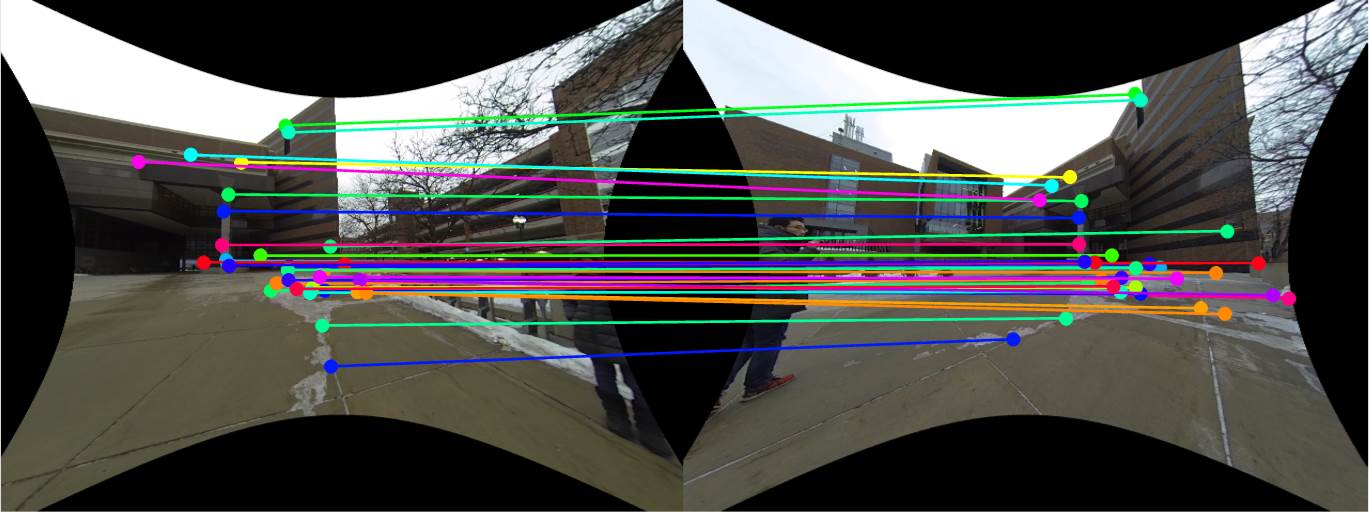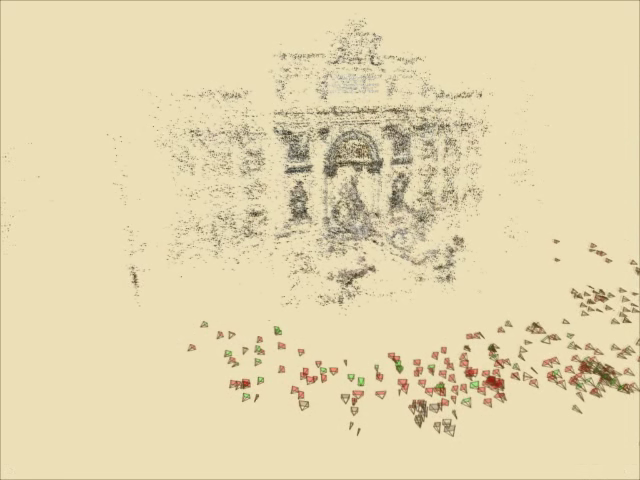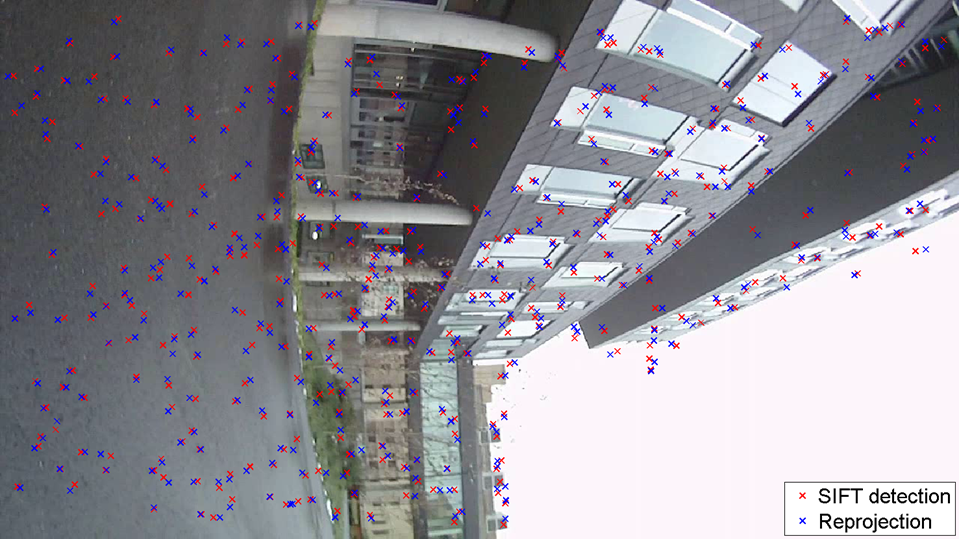Spring 2017 CSCI 5980/8980
Multiview 3D Geometry in Computer Vision
Tue/Thr 4:00pm-5:15pm @ Rapson Hall 43
|
Description

Multiple cameras are continually capturing our daily events involving social and physical interactions in a form of first person camera (e.g., google glass), cellphone camera, and surveillance camera. Multiview geometry is a core branch in computer vision that studies the 3D spatial relationship between cameras and scenes. This technology is used to localize and plan robots, reconstruct a city, e.g. Rome, from internet photos, and understand human behaviors using body-worn cameras. In this course, we will focus on 1) fundamentals of projective camera geometry; 2) implementation of 3D reconstruction algorithm; and 3) research paper review. The desired outcome of the course is for each student to have his/her own 3D reconstruction algorithm called "structure from motion''. This will cover core mathematics of camera multiview geometry including perspective projection, epipolar geometry, point triangulation, camera resectioning, and bundle adjustment. This geometric concept will be then, in parallel, implemented to directly apply to domain specific research such as robot localization.
|
Information
Instructor: Hyun Soo Park (hspark at umn dot edu)
Syllabus: pdf
Moodle: https://ay16.moodle.umn.edu/course/view.php?id=13616
Office hour: Tue/Thr 2:00pm-4:00pm (Keller Hall 5-225E)
Prerequisite: Linear Algebra
Textbook: Not required but the following book will be frequently referred:
"Multiple View Geometry in Computer Vision", R. Hartley and A. Zisserman

|
Topic
| Single view |
Camera model
Camera projection matrix
Projective line
Single view metrology
Image transformation
Estimation I (Linear algebra)
Camera calibration
Rotation representation
Where am I? (vanishing lines)
Where am I? (pnp)
|
Multiview |
Epipolar geometry
Fundamental matrix
Triangulation and stereo
Feature and matching
Estimation II (robust modeling)
Estimation III (nonlinear optimization)
Bundle adjustment I (geometric error)
Bundle adjustment II (spare structure and analytic jacobian)
Bundle adjustment III (implementation)
|
|
Schedule
The course will not directly follow the textbook but students may want to read the related book chapter for deeper understanding.
c: Paper committee
| Date |
Topic |
Slide |
Book ch. |
Homework |
Paper pres. |
| Jan 17 |
Computer Vision Introduction |
pdf | |
|
|
| Jan 18 |
Camera Model |
pdf |
Ch. 6 | | |
| Jan 24 |
Camera Projection Matrix |
pdf |
Ch. 6, 7 |
HW #1 out | |
| Jan 26 |
Projective Line I |
pdf |
Ch. 2 | | |
| Jan 31 |
Projective Line II |
pdf |
Ch. 2 | | |
| Feb 2 |
Where am I? (Vanishing Point) / Single View Metrology |
pdf | Ch. 8 |
HW #1 due | |
| Feb 7 |
Image Transformation |
pdf | Ch. 2 |
HW #2 out | |
| Feb 9 |
Linear Least Squares / Homography Computation |
pdf |
Ch. 2, A4, A5 | | |
| Feb 14 |
Fun with Homography / Camera Calibration |
pdf | Ch. A4, A5, 4 |
| |
| Feb 16 |
Camera Calibration (checkerboard pattern)
MATLAB calibration toolbox |
pdf | |
HW #2 due | |
| Feb 21 |
Where am I? (Homography) / Tour into Photo |
pdf | |
HW #3 out | |
| Feb 23 |
Rotation Representation |
pdf | |
| |
| Feb 28 |
Rotation Representation / Epipolar Geometry |
pdf | |
| Paper selection due |
| Mar 2 |
Rotation Representation / Epipolar Geometry |
pdf | |
| |
| Mar 7 |
Epipolar Geometry |
pdf | |
| |
| Mar 9 |
Fundamental Matrix Computation / Where am I? (Relative Pose) |
pdf | |
HW #3 due | |
| Mar 14 & 16 |
Spring Break |
| |
| |
| Mar 21 |
No class |
| |
HW #4 out | |
| Mar 23 |
Where am I? (Relative Pose) / RANSAC |
pdf | |
| |
| Mar 28 |
RANSAC |
pdf | |
| |
| Mar 30 |
Triangulation and Stereo |
pdf | |
| |
| Apr 4 |
Stereo and PnP |
pdf | |
HW #4 due and HW #5 out | Tong Ke pdf
c: Cheng Peng |
| Apr 6 |
Recitation (Shan Su) |
pdf | |
| |
| Apr 11 |
PnP and Nonlinear Estimation |
pdf | |
| Cheng Peng pdf
c: Jiawei Mo |
| Apr 13 |
Nonlinear Estimation |
pdf | |
HW #5 due | Jingbin Yang pdf
c: Sanfer D'souza |
| Apr 18 |
Jacobian |
pdf | |
HW #6 out, Data | Tien Do pdf
c: Aarti Sundararjan |
| Apr 20 |
Jacobian and Bundle Adjustment |
pdf | |
| Anushree Jagrawal pdf
c: Tong Ke |
| Apr 25 |
Bundle Adjustment |
pdf | |
| Jiawei Mo pdf
c: Tien Do |
| Apr 27 |
HW #6 review |
pdf | |
| Aarti Sundararjan pdf
c: Jingbin Yang |
| May 2 |
Tomasi-Kanade Factorization |
pdf | |
| Sanfer D'souza pdf
c: Anushree Jagrawal |
| May 4 |
HW #6 review and Future Computer Vision |
pdf | |
HW #6 due | |
|
MATLAB Code
Example codes can be found here.
|
Paper reading
Format: 20 min presentation and 15+ min Q&A.
Presenter: defending the paper.
Committee: attacking the paper.
| Recommended paper |
|
|
|
| Tomasi and Kanade, Shape and Motion from Image Streams under Orthography: a Factoriaztion Method, IJCV, 1992
|
|
|
|
| Reid and Zisserman, Goal-directed Video Metrology, ECCV, 1996
|
|
|
|
| Zhang, A Flexible New Technique for Camera Calibration, PAMI, 2000
|
|
|
|
| Nister, An Efficient Solution to the Five-Point Relative Pose Problem, PAMI, 2004
|
|
|
|
| Criminisi, Reid, and Zisserman, Single View Metrology, IJCV, 2000
|
|
|
|
| Xiao and Furukawa, Reconstructing the World’s Museum, IJCV, 2014
|
|
|
|
| Izadi et al., KinectFusion: Real-time 3D Reconstruction and Interaction
Using a Moving Depth Camera, UIST, 2011
|
|
|
|
|
Homework
|
Grading policy
90%: 6 programming assignments (15% each)
10%: paper presentation
Late submission: 20% off from each extra late day
For 8980: scalable SfM implementation running +30 images
|
Scholastic Misconduct
Scholastic misconduct is broadly defined as "any act that violates the right of another student in academic work or that involves misrepresentation of your own work. Scholastic dishonesty includes, (but is not necessarily limited to): cheating on assignments or examinations; plagiarizing, which means misrepresenting as your own work any part of work done by another; submitting the same paper, or substantially similar papers, to meet the requirements of more than one course without the approval and consent of all instructors concerned; depriving another student of necessary course materials; or interfering with another student's work."
|







